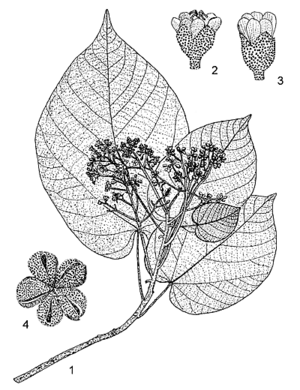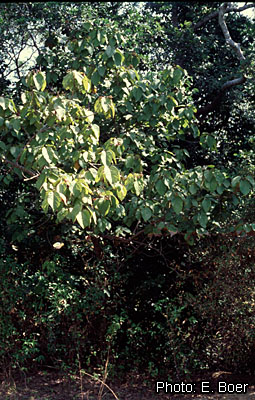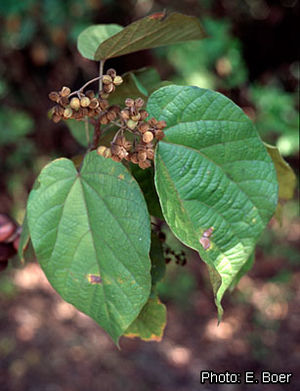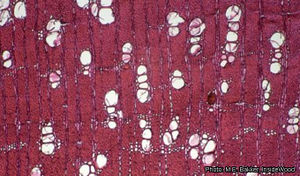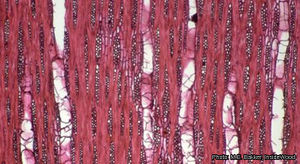Christiana africana (PROTA)
Introduction |
- Protologue: Prodr. 1: 516 (1824).
- Family: Tiliaceae (APG: Malvaceae)
Origin and geographic distribution
Christiana africana is widely distributed in tropical Africa, from Senegal to Kenya, Tanzania and Angola, and in Madagascar. It also occurs in tropical America.
Uses
The wood of Christiana africana is made into axe-handles, stools and basins. The leaves are used for wrapping cola nuts and foods to be sold in the market. In Ghana they serve as bait in fish- and prawn-traps. In the Central African Republic a maceration of the leaf is used in washings against diarrhoea and palpitations, and an infusion of young leaves is drunk hot to treat dysentery. Bark preparations are used in West and Central Africa to treat stomach problems and gonorrhoea.
Properties
The sapwood of Christiana africana is whitish yellow to pale brown, the heartwood darker with purplish blue ripple marks. The wood is heavy, hard, resilient and durable.
Three compounds that have cardiotonic activity have been isolated from the bark and wood: the polyphenol scopoletol, the triterpene taraxerol and the peptide alkaloid frangulanine.
Description
- Dioecious shrub or small tree up to 14 m tall with stellate hairs; bole short, with a diameter up to 60 cm; bark brown, rough, more or less fissured, fibrous; crown spreading; branchlets shortly brown-hairy.
- Leaves alternate, simple; stipules filiform, c. 6 mm long; petiole up to 26 cm long, shortly hairy; blade ovate to oblong, 9–32 cm × 5–28 cm, base cordate, apex acuminate, margin entire or slightly wavy, glabrous or slightly stellate-pubescent above, stellate-pubescent below, palmately veined with 5–9 pairs of lateral veins of which 2–3 pairs basal.
- Inflorescence an umbel-like cyme, axillary or terminal, up to 22 cm long, many-flowered, shortly hairy; peduncle 5–13 cm long; bracts filiform, 4–6 mm long.
- Flowers functionally unisexual, regular; pedicel 2–5 mm long; calyx campanulate, 3–5-lobed, lobes ovate and c. 3 mm long; petals 5–9, oblong-spatulate, 4–7 mm × 2–3.5 mm, white, glabrous; stamens numerous, fused at base, sterile in female flowers; ovary consisting of (2–)5–7 free carpels, styles 5–7, fused for most of their length.
- Fruit consisting of (2–)5–7 ellipsoid follicles 8.5–13 mm × c. 8 mm, shortly brown hairy, each splitting into 2 boat-shaped valves and 1-seeded.
- Seeds almost globose, c. 6 mm × 5.5 mm, marbled.
- Seedling with epigeal germination; cotyledons thin, rounded, 3-veined from the base; first leaves simple, alternate, toothed.
Other botanical information
Christiana comprises 5 species, of which only Christiana africana occurs in tropical Africa.
The seeds of Christiana africana usually germinate 15–20 days after sowing. In Côte d’Ivoire Christiana africana flowers in June and fruits in October–February; in Kenya it flowers in July.
Ecology
Christiana africana occurs in humid evergreen to dry semi-deciduous forest, often on the banks of streams, up to 400 m altitude.
Genetic resources
In view of its extremely wide distribution Christiana africana is not threatened by genetic erosion. Research on the genetic variability may shed light on the origin and spread in areas as far apart as tropical America, continental Africa and Madagascar.
Prospects
Very little is known about the properties and management of Christiana africana, but there are no indications that its role will become more important than that of a local source of wood, wrapping material and traditional medicines. There are many alternative sources of the constituents isolated.
Major references
- Beentje, H.J., 1994. Kenya trees, shrubs and lianas. National Museums of Kenya, Nairobi, Kenya. 722 pp.
- Burkill, H.M., 2000. The useful plants of West Tropical Africa. 2nd Edition. Volume 5, Families S–Z, Addenda. Royal Botanic Gardens, Kew, Richmond, United Kingdom. 686 pp.
- Whitehouse, C., Cheek, M., Andrews, S. & Verdcourt, B., 2001. Tiliaceae & Muntingiaceae. In: Beentje, H.J. (Editor). Flora of Tropical East Africa. A.A. Balkema, Rotterdam, Netherlands. 120 pp.
Other references
- Aké Assi, L., Abeye, J., Guinko, S., Riguet, R. & Bangavou, X., 1985. Médecine traditionnelle et pharmacopée - Contribution aux études ethnobotaniques et floristiques en République Centrafricaine. Agence de Coopération Culturelle et Technique, Paris, France. 140 pp.
- Bouquet, A. & Debray, M., 1974. Plantes médicinales de la Côte d’Ivoire. Travaux et Documents No 32. ORSTOM, Paris, France. 231 pp.
- de la Mensbruge, G., 1966. La germination et les plantules des essences arborées de la forêt dense humide de la Côte d’Ivoire. Centre Technique Forestier Tropical, Nogent-sur-Marne, France. 389 pp.
- Keay, R.W.J., 1958. Tiliaceae. In: Keay, R.W.J. (Editor). Flora of West Tropical Africa. Volume 1, part 2. 2nd Edition. Crown Agents for Oversea Governments and Administrations, London, United Kingdom. pp. 300–310.
- Kubitzki, K., 1995. Asterophorum and Tahitia congeneric with Christiana (Tiliaceae). Botanische Jahrbücher für Systematik, Pflanzengeschichte und Pflanzengeographie 116(4): 537–542.
- Normand, D., 1955. Atlas des bois de la Côte d’Ivoire. Tome 2. Centre Technique Forestier Tropical, Nogent-sur-Marne, France. 132 pp.
- Normand, D. & Paquis, J., 1976. Manuel d’identification des bois commerciaux. Tome 2. Afrique guinéo-congolaise. Centre Technique Forestier Tropical, Nogent-sur-Marne, France. 335 pp.
- Payen-Fattaccioli, L., 2004. Etude phytochimique et biologique d’une Tiliaceae camerounaise: Christiana africana DC. Journal de Mycologie Médicale 14(2): résumés des thèses.
Author(s)
- M. Brink, PROTA Network Office Europe, Wageningen University, P.O. Box 341, 6700 AH Wageningen, Netherlands
Correct citation of this article
Brink, M., 2006. Christiana africana DC. In: Louppe, D., Oteng-Amoako, A.A. & Brink, M. (Editors). PROTA (Plant Resources of Tropical Africa / Ressources végétales de l’Afrique tropicale), Wageningen, Netherlands. Accessed 22 December 2024.
- See the Prota4U database.

